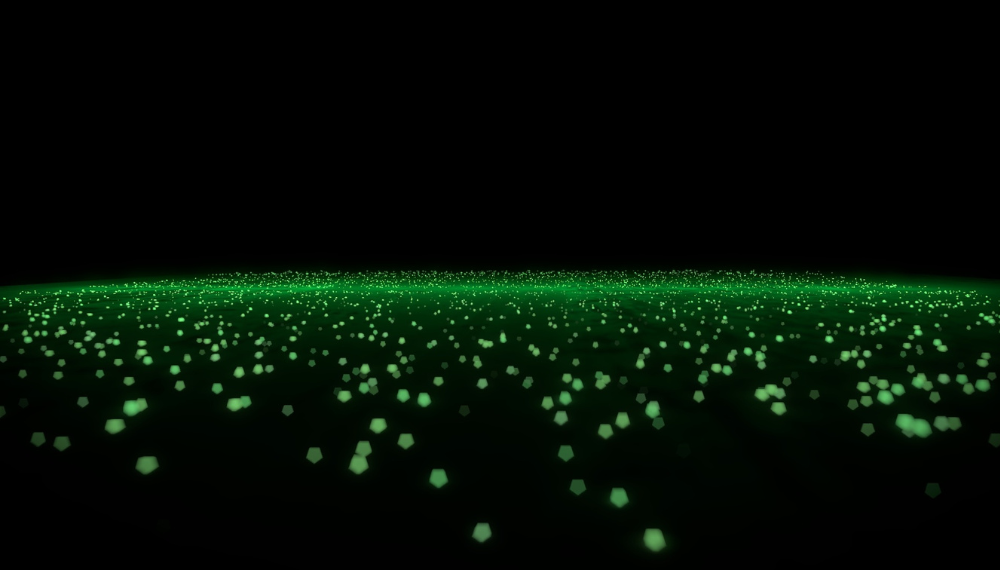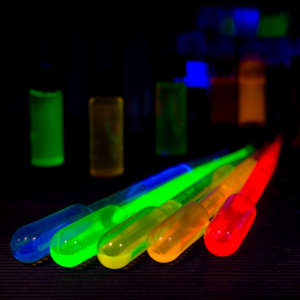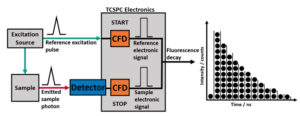Antibunching is a quantum phenomenon demonstrating the particle-like nature of light. It describes a light field where photons exhibit more uniform temporal spacing than that of a coherent light source, such as a laser.1
Antibunching occurs because a single-photon source can only emit one photon at a time. In contrast, classical light sources, such as fluorescence from a large number of molecules, produce photons at random intervals.
After excitation, a single photon source must return to its ground state before another photon can be emitted. Consequently, the probability of emitting closely spaced photons is significantly reduced, especially as the time between photon emissions gets shorter than the excited-state lifetime.
Antibunching serves as a valuable tool for identifying single-photon emitters, including single molecules, quantum dots, and carbon nanotubes. These emitters are essential for advancing quantum technologies such as quantum networks, cryptography, and computing, making the characterisation of their antibunching properties increasingly important.
Edinburgh Instruments’ MicroPL and RMS1000 microscopes can be upgraded to include antibunching capabilities, making them ideal for investigating single photon emitters for quantum applications.
Light can be characterised by how the photon arrivals are distributed. A stream of photons emitted from a sample can either be described as antibunched, random, or bunched (Figure 1). These states can be differentiated by how well they conform to a Poisson distribution.
Figure 1. Comparison of photon streams for antibunched, coherent, and bunched light.
Poissonian distribution is a statistical tool that is used to describe the probability of a given number of events, in this case number of photons detected, occurring in a fixed interval of time. It assumes these events occur with a known constant mean rate and independently of the time since the last event (Figure 2). For Poissonian distribution the mean is equal to the variance.
A super-Poissonian distribution has a variance greater than its mean. The events are clustered or bunched together more than expected from a Poisson process. In contrast, a distribution is sub-Poissonian when its variance is less than its mean. This indicates that the events are more regularly spaced than would be expected in a purely random distribution.
Figure 2. Comparison of Poissonian, super-Poissonian and sub-Poissonian distributions.
Light exhibiting Poissonian statistics, such as that from many coherent sources, displays random time intervals between photon detection.
In bunched light the photons cluster together meaning that if a photon is detected at time t=0 there is a higher probability of detecting another within a short time, displaying super-Poissonian photon statistics. Thermal light sources typically exhibit bunched photons.
Antibunched light, generated by single-photon emitters, displays sub-Poissonian statistics. This means the photons have more regular spacing between them. The classification of photons in light is summarised in Table 1.
Table 1. Classification of light according to photon time intervals.
| Photon Stream | Classical Description | g(2)(0) | Photon Statistics |
|---|---|---|---|
| Antibunched | None | <1 | Sub-Poissonian |
| Random | Coherent | 1 | Poissonian |
| Bunched | Chaotic | >1 | Super-Poissonian |
This classification includes the second-order correlation function g(2)(τ), where τ is the time interval between photon detection. This function quantifies the correlation between photons emitted by a light source at different time intervals.
Photon antibunching is characterised by g(2)(0) < 1, indicating a lower probability of detecting two photons simultaneously compared to a coherent source where g(2)(0) = 1. The temporal profile of g(2)(τ) for a single-photon emitter shows a dip at τ=0 (Figure 3).
Bunched light is characterised by g(2)(0) > 1, indicating a higher probability of detecting two photons simultaneously compared to a coherent source. This means that photons tend to arrive in clusters. The temporal profile of g(2)(τ) for bunched light shows a peak at τ = 0.
Perfect photon antibunching corresponds to g(2)(0) = 0, meaning a zero probability of detecting two photons at the same time. However, background noise and sample imperfections can lead to a non-zero value of g(2)(0) in practical measurements.
Figure 3. Second order coherence function g(2)(τ) versus time decay for antibunched, coherent and bunched light sources.
Antibunching can be measured using the classic Hanbury Brown-Twiss (HBT) experiment.2 This experiment uses the Time Correlated Single Photon Counting (TCSPC) method.
In this setup, emitted light from a sample is split by a 50/50 beam splitter and directed to two separate detectors (Figure 4). Detector one provides the start pulse to the TCSPC device, and detector two provides the stop pulse.
The stop pulses are delayed by a few nanoseconds to place the coincidence point (the time difference between start and stop pulses) in the centre of the recording-time interval. This delivers a histogram of the time difference between the photons arriving at the two detectors.
A single photon cannot be split between two detectors; therefore, each photon will arrive at either one detector or the other. This prevents simultaneous detection of two photons. The result is that the histogram has a dip at the coincidence point (time difference of zero). The depth of the dip depends on the number of independent emitters in the observation volume with a deeper dip for fewer emitters. The shape of the dip depends on the excited-state lifetime, the dip is wider for longer lifetimes.
Figure 4. Hanbury Brown-Twiss experiment.
Photon antibunching is used to identify single-photon emitters in a sample. This can include single fluorescent molecules, carbon nanotubes, quantum dots, and nitrogen vacancy centres in diamonds.
By utilising the unique properties of these emitters, they can be used for super-resolution microscopy. This aims to overcome the diffraction limit inherent in all optical instruments to achieve higher spatial resolution.
Quantum emitters, often used as fluorescent markers in biological imaging, can be spatially separated by ensuring that only one emitter is detected at a time, preventing overlapping signals. This is achieved by taking advantage of the time gaps between photon emissions from a single emitter, a direct result of antibunching.
Beyond microscopy, single-photon emitters have a wide range of uses, making photon antibunching a crucial technique for quantum applications (Table 2).
Table 2. Applications of photon antibunching.
| Application | How is Photon Antibunching used? |
|---|---|
| Quantum Communications | Antibunching ensures the reliable transmission of single photons, vital for secure quantum key distribution (QKD) and building robust quantum networks over long distances. |
| Quantum Computing | Antibunched photons serve as qubits, enabling the development of photonic quantum computers and facilitating quantum information processing. |
| Quantum Cryptography | Requires single-photon sources with low g(2)(0) to ensure secure communication by preventing eavesdropping based on photon splitting. |
| Fundamental Quantum Mechanics Research | To study the fundamental properties of quantum states, entanglement, and coherence, validating quantum mechanics and refining theoretical models. |
| Quantum Sensing and Metrology | Antibunched light improves measurement sensitivity, allowing for more accurate calibrations and measurements. |
| Development of Quantum Networks | Relies on single photon sources to transmit information reliability to link multiple quantum devices across large distances e.g. for space. |
| Medical Imaging and Diagnostics | Antibunching reduces background noise in single-photon emission computed tomography (SPECT), leading to clearer images and more accurate medical diagnostics. |
| Optical Computing | Single photon sources are used for processing and transmitting information using light instead of electricity. |
As quantum technologies continue to advance, the ability to generate and characterise antibunched light will play an increasingly vital role. From secure communication networks to powerful quantum computers and enhanced medical diagnostics, the unique properties of single-photon emitters, revealed by antibunching, are poised to revolutionise numerous fields.
References


